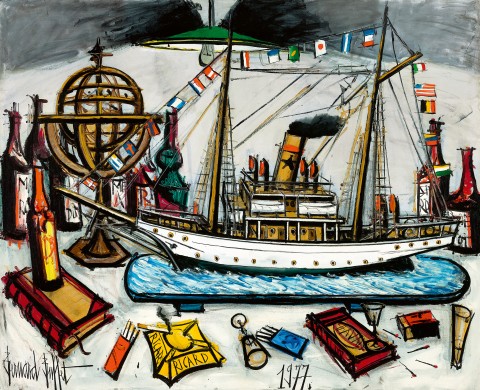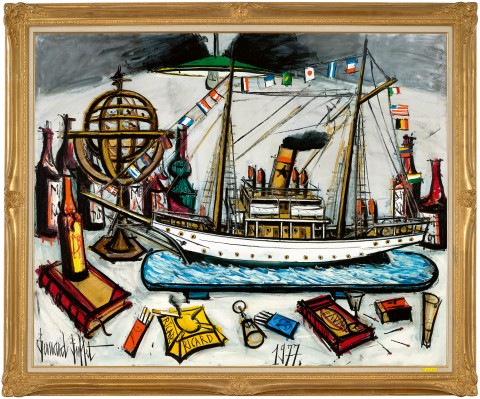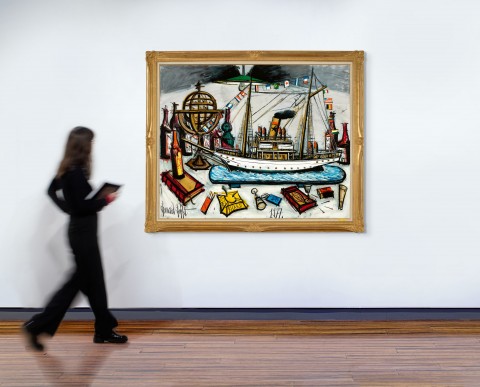HURRAH!! PORTOVENERE!, 1977
BERNARD BUFFET
oil on canvas
130.5 x 162.5 cm
signed lower left: Bernard Buffet
dated lower centre: 1977.
inscribed with title verso: Hurrah!! / Portovenere!
Galerie Maurice Garnier, Paris (bears gallery stamp verso)
Private collection, Japan, acquired from the above in January 1989
Thence by descent
Private collection, Queensland
We are grateful to Galerie Maurice Garnier, Paris, for their assistance with this catalogue entry.
Buffet (1).jpg
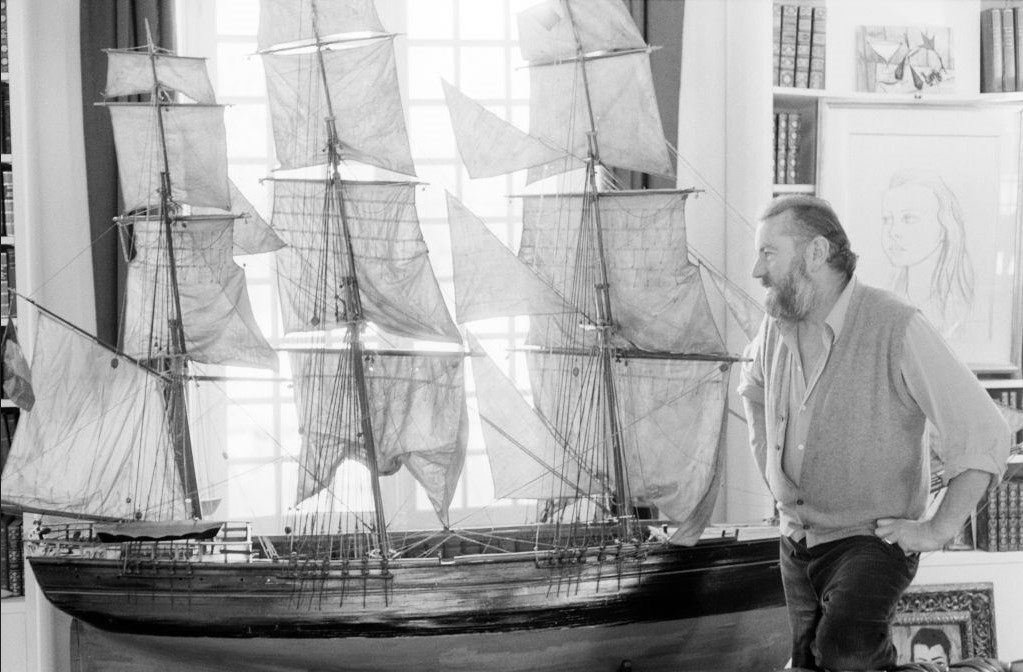
Bernard Buffet, once hailed as France’s finest post-war painter1, and reaching dizzying heights of fame and fortune before his thirtieth birthday, later suffered from critical denigration within his home country. Particularly damaging were exposés of Buffet’s lavish lifestyle presented in the illustrated press – a distasteful display in the eyes of the French public. As a member of the L’Homme Témoin (Man as Witness) group supporting expressive social realism, Buffet’s works from the 1950s and 60s were infused with Gallic spleen.2 Sapped of colour and spatial depth, they reflected the lingering malaise and material privations of Post-War Europe, to which Buffet now appeared to be immune. Flush from successful commercial exhibitions, Buffet nevertheless weathered the public relations storm, and continued to indulge in his penchant for extravagant real estate. By 1971 he was buying his third château, a newly restored 13th-century moated castle near Versailles on the outskirts of Paris, living there with his wife Annabel and their growing brood.
It was within the thick walls of this Château de Villers-le-Mahieu that Hurrah!! Portovenere!, 1977 was painted, with gestural emphasis, by artificial lamplight in the wee hours. Inching towards his 50th birthday, Buffet had just traversed a tumultuous and exhausting decade during which he had become a Chevalier de la Légion d’Honneur and the youngest member ever elected to the Académie des Beaux-Arts; had been embroiled in copyright litigations (both as plaintiff and defendant); and after a health scare, had monastically adopted years of ‘exemplary sobriety without complaining’.3 Hurrah!! Portovenere!, with its enthusiastic exclamation points, appears to be an allegorical vanitas painting, in which Buffet has matter-of-factly displayed an array of his recently rediscovered vices. Nicholas Foulkes wrote in his 2016 biography of the artist that Buffet appears to have resumed drinking at the end of 1975, encouraged by his wife Annabel, who had been anxious to see the return of her seductive and moody drinking partner.4 Annabel recalled in her own memoir: ‘on my advice - he changed the strictness of his regime. He allowed himself some champagne or wine, and then he began smoking again. He lost weight. He was rejuvenated. I found that once again he sparkled with life’.5
Prolifically working in thematic suites throughout his career (both for annual Maurice Garnier exhibitions and for his own artistic resolutions), this still life belongs to a series from 1977 of expressive table-top arrangements, each
Buffet ship.jpg
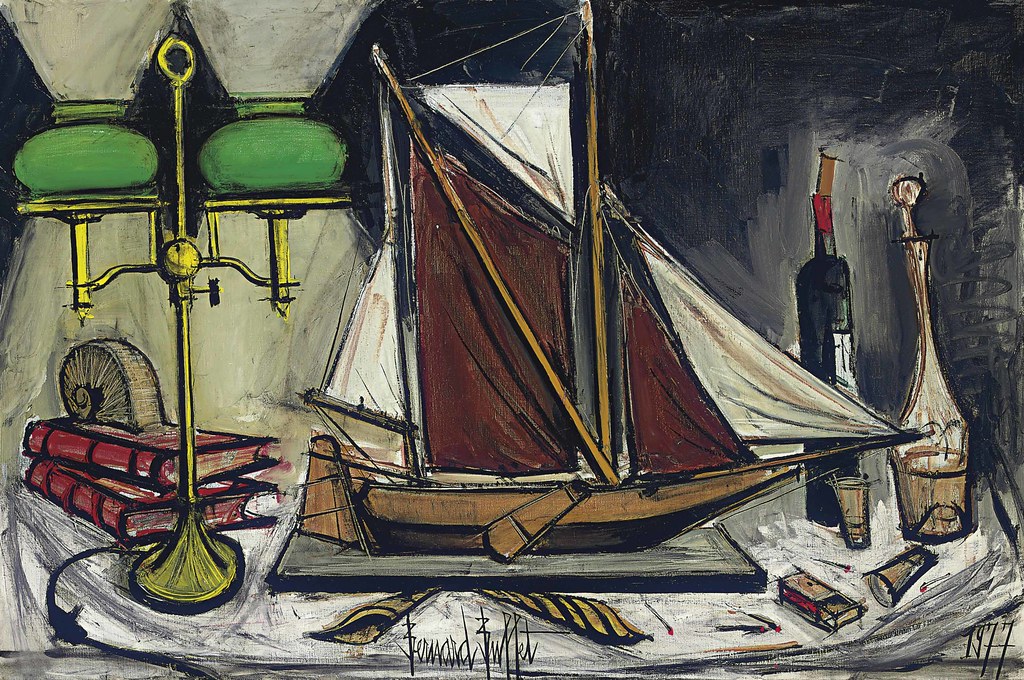
illuminated by triangular beams of stark lamplight. The symbolic objects of Buffet’s fickle lifestyle were scattered cigarettes in red and blue coloured packets, Havana cigars and spent matches, upturned crystal apéritif glasses, bottles of spirits and wine dripping with red wax, playing cards and a roulette wheel, pistols, a skull, a globe, a pile of leatherbound books and an assortment of model ships. While some of these compositions bore titles relating to the model ship, others had metaphorical titles, such as Le Grand Jeu (The Great Game).
In the early years of the 1970s, Buffet had become increasingly reclusive and feverishly painted sentimental landscapes, many depicting busy harbours of the Breton coast where he had holidayed with his mother in the 1940s. Returning to these maritime themes in his 1977 still lives, Buffet incorporated amongst the relics of his bon-vivant excesses, large model ships – at least four different historical models. Buffet’s library in the château was vast, and purportedly accommodated several large-scale models of yachts and ships from the great days of sailpower.6
While the title of Hurrah!! Portovenere! contains both an international maritime celebratory exclamation and the name of a picturesque Ligurian port, the relationship between this title and the model of a two-masted steam-powered schooner within the image is unclear. Whimsically, Buffet has painted plumes of black smoke belching from the model ship’s singular funnel, mirroring the plume of smoke from his own unfinished Gauloise cigarette, balancing on a bright yellow ashtray advertising Ricard pastis. Further emphasising the celebratory atmosphere of toasts and enthusiastic cheers, Buffet’s model ship, gleaming with unpainted white gesso, is ‘dressed overall’. Carefully detailed in the artist’s characteristic graphic style, the ship is decked out with flags in the time-honoured naval tradition for celebrating national holidays, regattas or special occasions. Only Buffet has either misunderstood or taken creative liberties with this custom, painting instead of the required international signal flags and pennants, an array of national flags including that of France, Italy, Belgium, the United States and Japan. Accompanied by a stylised globe on a stand, Buffet is perhaps alluding to his increasing global fame and reflecting on his inability to meet it. In 1973, when a museum in his honour had been inaugurated in Japan, Buffet had declined an invitation to attend, writing in apology ‘do not take my absence as a sign of indifference – I am a solitary person’.7 Buffet’s son believed that while his father had thought it morbid and premature to memorialise him with a dedicated museum during his lifetime, he regretted his absence from the celebrations for the rest of his life.8
1. Connaissance des Arts, Paris, No. 36, 15 February 1955
2. Coined by writer Charles Baudelaire, ‘spleen’ describes a French feeling of melancholy and existential ennui.
3. Buffet, A., D’amour et d’Eau Fraîche, Messinger, Paris, 1986, p. 275
4. Foulkes, N., Bernard Buffet: The Invention of the Modern Mega-Artist, Arrow Books, London, 2016, p. 350
5. Buffet, op. cit., p. 276
6. Foulkes, op. cit., p. 297
7. Musee Bernard Buffet, reproduced in Foulkes, ibid., p. 315
8. Nicholas Buffet, interview with Foulkes, February 2015, cited in Foulkes, ibid., pp. 315 – 16
LUCIE REEVES-SMITH
